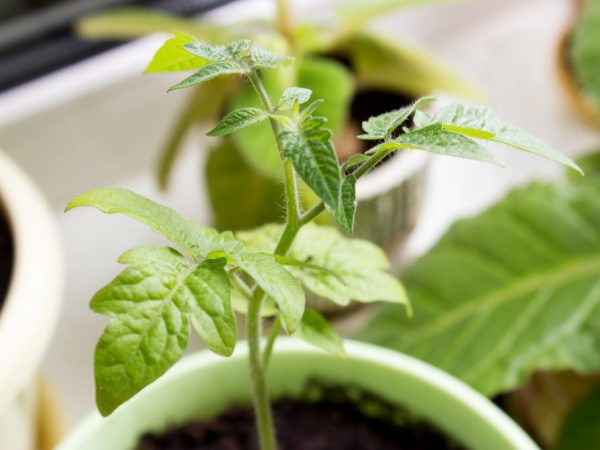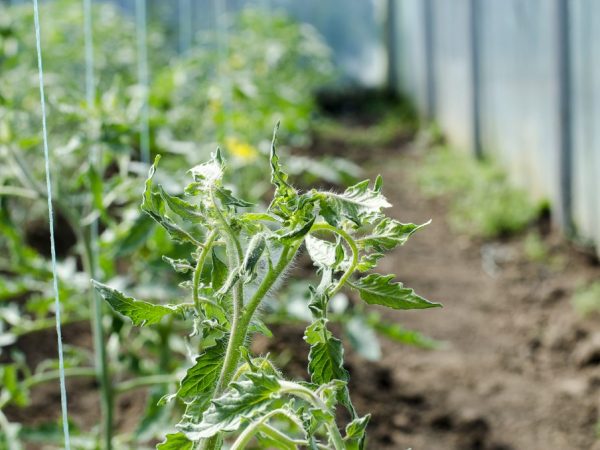Causes of pale tomato seedlings
Some vegetable growers are faced with the fact that tomatoes stop growing, shed their ovaries, and do not produce a crop. Pale tomato seedlings are also one of the serious problems, which indicates the abnormal development of the bush. In most cases, culture can be saved if changes are noticed in time.

Causes of pale tomato seedlings
Causes
Before trying to get rid of the problem of pale leaves, you need to find out the reasons for this phenomenon. Gardeners distinguish several factors that affect the color change of the green mass of a tomato:
- the plant receives excess moisture;
- tomatoes don't get enough heat;
- tomatoes feel a lack of oxygen;
- the culture grows in a poorly lit area;
- planting tomatoes are thickened;
- the root system of the culture is damaged;
- tomatoes lack nutrients.
You should not step back when identifying any of the reasons. It is necessary to take measures to eliminate them.
Excess moisture
Tomatoes love moisture. But it is impossible to allow waterlogging of the soil under the seedlings, and therefore it is recommended to water it once every 3 days. This can be due to frequent watering or high humidity in the room.
An excess of moisture leads to the fact that the root system of the vegetable crop begins to rot. This is followed by the gradual dying off of the shoots. The foliage turns pale and takes on a lifeless look. To prevent the death of the plant, it is necessary to adjust the frequency of watering the seedlings. The signal for watering tomatoes is slightly dried soil.
You can get rid of excess moisture by organizing periodic ventilation of the premises with seedlings. In this case, take care of the absence of drafts.
Temperature
For the comfortable growth of tomatoes, a temperature of 22 to 27 ° C is required. Nighttime thermometer readings must be at least 16 ° C. The difference between day and night temperatures can be no more than five degrees.
To create such conditions, it is recommended to build film shelters. They must be airtight and wind resistant.
Tomatoes can easily withstand a heat of 40 ° C for just two days. After that, the culture stops the process of photosynthesis.
Vegetable growers recommend leaving the windows and doors of the greenhouse open during hot summer periods. If the vegetable beds are outdoors, a shade canopy should be built.
Plentiful morning watering will help to transfer the intense heat to the plants without damage. The root zone should be watered, try to prevent moisture from entering the tomato foliage.
Shine

Lack of light can be detrimental to plants.
Lack of illumination of tomato beds negatively affects the culture. Thin stems and pale leaves are just the beginning of the trouble. If you do not respond to these signals, then the volume of the harvest will be small. Rules to adhere to in cultivating a culture:
- To protect tomato seedlings from such problems, use natural light as much as possible.When constructing a greenhouse, use fewer ceilings, periodically wipe the windows.
- For a tomato, daylight hours can last from 14 to 16 hours. If the tomatoes are in the light for a longer amount of time, then the leaves of the culture are covered with whitish spots.
- When growing seedlings in winter, it is worth taking care of additional lighting for the sprouts. For this, ultraviolet lamps are suitable. They are positioned so that the tomatoes receive direct light.
- In open beds, tomato leaves become colorless due to burns. This phenomenon can be observed during summer periods when the air temperature is too high. In this case, you should take care of an artificial shading structure.
- If the seedlings are burned, then the damaged leaves are removed, and the rest of the plant is processed by Epin. This will help the healthy part of the tomato to cope with the effects of excessive light.
Dense beds
Each gardener himself chooses the width of the tomato beds, the distance between the seedlings. When planting seedlings in open ground, remember that plants planted too close in tomato beds will constantly stretch upward. The sprouts will become tall and thin. The green foliage will turn white.
This is because, as the tomatoes develop, they cast a shadow over each other. Culture does not receive enough light.
Each sprout is placed in a prepared well. They are placed at a distance of 60 cm to 1 m.
Root damage
Pale leaves on tomatoes indicate damage to the root system. This happens when the shoots are transplanted to a permanent place on the prepared beds. Thin upper roots break off, the plant receives less nutrients.
With properly organized care, the root system of the culture will grow rapidly, the plant will get stronger, young green leaves will replace pale foliage.
Lack of nitrogen
Pale seedlings in tomatoes can also be due to a lack of nitrogen. To solve the problem, a urea solution prepared at the rate of 40 grams of dry fertilizer per 10 liters of water is suitable. This top dressing is used instead of watering the root zone.
Gardeners recommend spraying tomato beds with a urea solution between waterings in the evening. Get carried away with the introduction of nitrogen-containing dressings. This leads to an exuberant growth of the green part of the plant.


